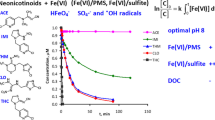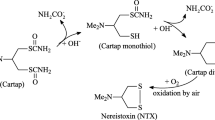Abstract
A Fenton oxidation system employing zero-valent iron (whose source was swarf, a residue of metallurgical industries, in powder form) and hydrogen peroxide for the treatment of an aqueous solution with six pesticides was developed, and the effect of the iron metal content, pH, and hydrogen peroxide concentration was evaluated. The characterization of the aqueous solution resulted in: pH 5.6, 105 mg L−1 of dissolved organic carbon, and 44.6 NTU turbidity. In addition, the characterization of the swarf by FAAS and ICP-MS showed 98.43 ± 7.40 % of zero-valent iron. The removal was strongly affected by the content of iron metal, pH, and hydrogen peroxide concentration. The best degradation conditions were 2.0 g swarf, pH 2.0, and 5 mmol L−1 H2O2. At the end of the treatment, the pesticide degradation ranged from 60 to 100 %, leading to 55 % mineralization. Besides, all hydrogen peroxide was consumed and the determination of total dissolved iron resulted in 2 mg L−1. Thus, the advantages of this system are rapid degradation (up to 20 min), high-degradation rates, simple handling, and low cost.

A Fenton oxidation system employing Fe0 (in which the source of Fe0 was swarf, a residue in powder form of metallurgical industries) and H2O2 for the degradation of synthetic wastewater comprising six pesticides was developed, and the effect of the amount of Fe0, pH, and H2O2 concentration was evaluated.










Similar content being viewed by others
References
ANC-135 (2012) Cations in drinking water using Metrosep C 4–150/4.0 column according to ISO 14911 and ANS-257 Seven standard anions separated on the column Metrosep A Supp 15–250/4.0–Metrohm Method, available at http://www.metrohm.com.br/aplicacoes/Metodos2.html. Accessed 09 May 2013
Arruda TL, Jardim WF (2007) Treatment of groundwater contaminated with chlorinated compounds using elemental iron and Fenton’s reagent. Quim Nova 30:1628–1632
Associação Brasileira de Normas Técnicas (ABNT) (2010) NBR 13934 – Water – Iron Determination Phenantroline Colorimetric Method, available at http://www.abntcatalago.com.br. Accessed 23 Oct 2012
Australian Pesticides and Veterinary Medicines Authority (APVMA) (2003) Evaluation of the new active pyraclostrobin in the product cabrio fungicide. Public release summary Australian Pesticides and Veterinary Medicines Authority, 2003. Canberra – Australia ISBN 1448-3076
Barreiro JC, Capelato MD, Martin-Neto L, Hansen HCB (2007) Oxidative decomposition of atrazine by a Fenton-like reaction in a H2O2/ferrihydrite system. Water Res 41:55–62
Benatti CT, Tavares CRG, Guedes TA (2006) Optimization of Fenton’s oxidation of chemical laboratory wastewater using the response surface methodology. J Environ Manage 80:66–74
Benatti CT, Tavares CRG, Lenzi E (2009) Sulfate removal from waste chemicals by precipitation. J Environ Manage 90:504–511
Cabrera L, Costa FP, Primel EG (2008) Risk estimate of water contamination by pesticide in south of Brazil. Quím Nova 31:1982–1986
Cabrera L, Caldas SS, Rodrigues S, Bianchini A, Duarte FA, Primel EG (2010) Degradation of herbicide Diuron in water employing the Fe0/H2O2 system. J Braz Chem Soc 21:2347–2352
Caldas SS, Demoliner A, Costa FP, D’Oca MGM, Primel EG (2010) Pesticide residue determination in groundwater using solid-phase extraction and high-performance liquid chromatography with diode array detector and liquid chromatography-tandem mass spectrometry. J Braz Chem Soc 21:642–650
Calza P, Baudino S, Aigotti R, Baiocchi C, Branca P, Pelizzetti E (2002) High-performance liquid chromatographic/tandem mass spectrometric of the phototransformation products of tebuconazole on titanium dioxide. J Mass Spectrom 37:566–576
Casero I, Sicilia D, Rubio S, Pèrez-Bendito D (1996) Chemical degradation of aromatic amines by Fenton’s reagent. Water Res 31:1985–1995
Demoliner A, Caldas SS, Costa FP, Gonçalves FF, Clementin RM, Milani MR, Primel EG (2010) Development and validation of a method using SPE and LC-ESI-MS-MS for the determination of multiple classes of pesticides and metabolites in water samples. J Braz Chem Soc 21:1424–1434
Eisenberg GM (1975) Colorimetric determination of hydrogen peroxide. Ind Eng Chem 15:327–328
Fan C, Tsui L, Liao MC (2011a) Parathion degradation and its intermediate formation by Fenton process in neutral environment. Chemosphere 82:229–236
Fan X, Hao H, Shen X, Chen F, Zhang J (2011b) Removal and degradation pathway study of sulfasalazine with Fenton-like reaction. J Hazard Mater 190:493–500
Fatta D, Canna-Michaelidou S, Michael C, Georgiou ED, Christodoulidou M, Achilleos A, Vasquez M (2007) Organochlorine and organophosphoric insecticides, herbicides and heavy metals residue in industrial wastewaters in Cyprus. J Hazard Mater 145:169–179
Fatta D, Michael C, Canna-Michaelidou S, Christodoulidou M, Kythreotou N, Vasquez M (2006) Pesticides, volatile and semivolatile compounds in the surface waters of Cyprus. Desalination 215:223–236
Gooddy DC, Chilton PJ, Harrison I (2002) A field study to assess the degradation and transport of diuron end metabolites in a calcareous. Sci Total Environ 7:67–83
Gözmen B, Kayan B, Gizir AM, Hesenov A (2009) Oxidative degradations of reactive blue 4 dye by different advanced oxidation methods. J Hazard Mater 168:129–136
Gulkaya I, Surucu GA, Dilek FB (2006) Importance H2O2/Fe2+ ratio in Fenton’s treatment of a carpet dyeing wastewater. J Hazard Mater 136:763–769
Hermosilla D, Cortijo M, Huang CP (2009) The role of iron on the degradation and mineralization of organic compounds using conventional Fenton and photo-Fenton processes. Chem Eng J 155:637–646
Jiang C, Pang S, Ouyang F, Ma J, Jiang J (2010) A new insight into Fenton and Fenton-like process for water treatment. J Hazard Mater 174:813–817
Kallel M, Belaid C, Boussahel R, Ksibi M (2010) Olive mill wastewater degradation by Fenton oxidation with zero-valent iron and hydrogen peroxide. J Hazard Mater 163:550–554
Kallel M, Belaid C, Mechichi T, Ksibi M, Elleuch B (2009) Removal of organic load and phenolic compounds from olive mill wastewater by Fenton oxidation with zero-valent iron. Chem Eng J 150:391–395
Kassinos D, Constantinou M, Varnava N, Papadopoulos A, Vlachos S, Mantzavinos D (2008) Oxidation of pesticides in water by Fenton and photo-Fenton reactions. J Adv Oxid Technol 11:246–253
Kassinos D, Varnava N, Michael M (2009) Homogeneous oxidation of aqueous solutions of atrazine and fenitrothion through dark and photo-Fenton reactions. Chemosphere 74:866–872
Khan E, Wirojanagud W, Sermsai N (2009) Effects of iron type in Fenton reaction on mineralization and biodegrability enhancement of hazardous organic compounds. J Hazard Mater 161:1024–1034
Klavarioti M, Mantizavinos D, Kassinos D (2011) Removal of residual pharmaceuticals from aqueous system by advanced oxidation processes. Environ Int 35:402–417
Laat J, Gallard H (1999) Catalytic decomposition of hydrogen peroxide by Fe(III) in homogeneous aqueous solution: mechanism and kinetic modeling. Environ Sci Technol 33:2726–2732
Lu LA, Ma YS, Kumar M, Lin JG (2011) Photochemical degradation of carbofuran and elucidation of removal mechanism. Chem Eng J 166:150–156
Mann PJ (2003) The e-pesticide manual, 13th ed. Version 3.0. British Crop Protection Council (BCPC), Alton, UK
Martín MMB, López JLC, Oller I, Malato S, Sánches-Pérez JA (2010) A comparative study of different tests for biodegrability enhancement determination during AOP treatment of recalcitrant toxic aqueous solutions. Ecotoxicol Environ Saf 73:1189–1195
Masomboon N, Chen CW, Anotai J, Lu MC (2010) A statistical experimental design to determine O-toluidine degradation by the photo-Fenton process. Chem Eng J 159:116–122
Melo SAS, Trovó AG, Bautitz IR, Nogueira RFP (2009) Degradation of residual pharmaceuticals by advanced oxidation process. Quim Nova 32:188–197
Namkung KC, Burgess AE, Bremmer DH, Staines H (2008) Advanced Fenton processing of aqueous phenol solutions: a continuous system study including sonication effects. Ultrason Sonochem 15:171–176
National Environmental Council (2005) (Ministério do Meio Ambiente, Conselho Nacional do Meio Ambiente) (CONAMA). Resolution no 357,03/17/2005. Available at http://www.mma.gov.br/port/conama/rs/res05/res35705.pdf Accessed 05 Dec 2012
Neyens E, Baeyens J (2003) A review of classic Fenton’s peroxidation as an advanced oxidation technique. J Hazard Mater 98:33–50
Oller I, Malato S, Sánches-Pérez JA (2011) Combination of advanced process and biological treatments for wastewater decontamination—a review. Sci Total Environ 409:4141–4166
Oturan MA, Oturan N, Edelahi MC, Podvorica FI, Kacemi K (2011) Oxidative degradation of herbicide diuron in aqueous medium by Fenton’s reaction based advanced oxidation processes. Chem Eng J 171:127–135
Oturan N, Trajkovska S, Oturan MA, Couderchet M, Aaron JJ (2008) Study of the toxicity of diuron and its metabolites formed in aqueous medium during application of the electrochemical advanced oxidation process “electro-Fenton”. Chemosphere 73:1550–1556
Pérez MH, Peñuela G, Maldonado MI, Malato O, Fernández-Ibañez P, Oller I, Gernjak W, Malato S (2006) Degradation of pesticides in water using solar advanced oxidation process. Appl Catal B Environ 64:272–281
Satapanajaru T, Comfort SD, Shea PJ (2003) Pilot-scale treatment of RDX-contaminates soil with zero-valent iron. J Environ Qual 32:1717–1725
Scherer MM, Johnson KM, Westall JC, Tratnyek PG (2001) Mass transport effects on the kinetics of nitrobenzene reduction by iron metal. Environ Sci Tecnol 35:2804–2811
Tang WZ, Tassos S (1997) Oxidation kinetics and mechanism of trihalomethanes by Fenton’s reagent. Water Res 31:1117–1125
Walling C (1975) Fenton’s reagent revisited. Acc Chem Res 8:125–131
Zapata A, Velegraki T, Sánchez-Pérez JA, Mantzavinos D, Maldonado MI, Malato S (2009) Solar photo-Fenton treatment of pesticides in water: effect of iron concentration on degradation and assessment of ecotoxicity and biodegrability. Appl Catal B Environ 88:448–454
Acknowledgments
The authors acknowledge the financial support and fellowships granted by the Brazilian agencies CAPES, FINEP, PETROBRAS, CORSAN and FURG. Part of this study was supported by a grant from the Brazilian Agency FAPERGS/CNPq (process number 010/0022‐0), CNPq/CAPES (process number 552318/2011‐6), CNPq (process number 477083/2011‐00), FAPERGS (process number 11/0816‐3), FAPERGS/PROCOREDES (process nº0905342), CAPES/PNPD (process number 23038.028239/2009‐69). E.G. Primel received a produc;vity research fellowship from the Brazilian Agency CNPq (DT 310517/2012‐5)
Author information
Authors and Affiliations
Corresponding author
Additional information
Responsible editor: Philippe Garrigues
Electronic supplementary material
Below is the link to the electronic supplementary material.
ESM Table 1
Calibration curves and results of LOD and LOQ values obtained by LC-ESI-MS/MS(DOCX 11 kb)
Rights and permissions
About this article
Cite this article
de S. Guimarães, B., Kleemann, N., Caldas, S.S. et al. Environmentally friendly system for the degradation of multipesticide residues in aqueous media by the Fenton’s reaction. Environ Sci Pollut Res 21, 584–592 (2014). https://doi.org/10.1007/s11356-013-1932-2
Received:
Accepted:
Published:
Issue Date:
DOI: https://doi.org/10.1007/s11356-013-1932-2




